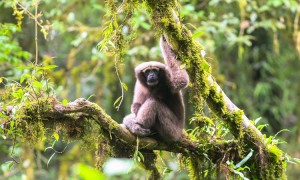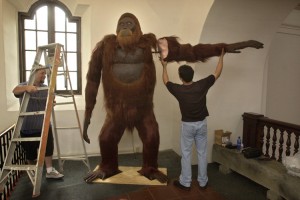The Star Wars Gibbon
Thursday, February 2nd, 2017February 2, 2017
Move over, Luke, there’s a new Skywalker in town! A new species (kind) of gibbon, the Skywalker hoolock gibbon, has been found living in the tropical rain forests of southwestern China and northeastern Myanmar. Gibbons are the smallest of the apes. The scientific name of this new species, Hoolock tianxing, describes a hoolock gibbon with “heaven’s movement” or, loosely, as a “skywalker.” The name refers to the gibbons’ graceful swinging through the treetops as well as the traditional Chinese view of these animals as mystical beings. Also, the scientists who studied the newly defined gibbons are huge Star Wars fans. (In case you didn’t know, Luke Skywalker is one of the heroes of the movie franchise.)

An adult female Skywalker hoolock gibbon contemplates the universe from its treetop home in southwestern China. Credit: © Fan Peng-Fei, Zoological Society of London
Researchers from Sun Yat-sen University in Guangzhou, China, along with experts from the Zoological Society of London (ZSL) in the United Kingdom, have been studying these gibbons since 2008. But only recently did the scientists realize that this hoolock gibbon was different from the two known species—eastern and western hoolocks. Skywalker hoolock gibbons have slightly different eyebrows and beards than their relatives, and they have their own unique calls.
Gibbons are small primates with long arms. They weigh from 10 to 20 pounds (5 to 9 kilograms) and stand 15 to 36 inches (38 to 91 centimeters) high. Adults typically range in color from black to light tan, with males often darker than females. Their long arms help them brachiate (swing from branch to branch) through the treetops where they live. They eat fruits and leaves and rarely come to the ground. Most gibbons inhabit the forests of such Southeast Asian nations as Indonesia, Malaysia, Myanmar, and Thailand. The rare hoolock gibbon has been spotted as far west as India.
Unfortunately, all gibbons, including this new species, are threatened in the wild. Scientists believe there are only 200 Skywalker hoolock gibbons left in their native habitat. Human beings have greatly reduced gibbon populations by destroying the animals’ forest homes and by capturing young animals for food or for sale as pets.



